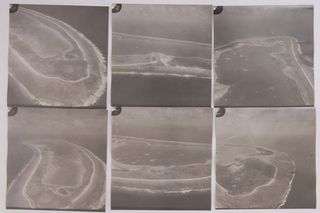Photos Could Prove Amelia Earhart Lived as Castaway

An array of detailed aerial photos of the remote island where Amelia Earhart may have survived for a time as a castaway, has resurfaced in a New Zealand museum archive, raising hopes for new photographic evidence about the fate of the legendary aviator.
Found by Matthew O'Sullivan, keeper of photographs at the New Zealand Air Force Museum in Christchurch, the images lay forgotten in an unlabeled tin box in the museum's archives.
The box contained five sheets of contact prints -- for a total of 45 photos, complete with negatives -- and a slip of paper with the words "Gardner Island."
PHOTOS: Sonar Possibly Reveals Earhart's Plane
Now called Nikumaroro, the uninhabited tropical atoll in the southwestern Pacific republic of Kiribati is believed to be Earhart final resting place by researchers of The International Group for Historic Aircraft Recovery (TIGHAR).
The legendary aviator disappeared while flying over the Pacific Ocean on July 2, 1937 in a record attempt to fly around the world at the equator.
A number of artifacts recovered by TIGHAR during 10 expeditions have suggested that Earhart and her navigator, Fred Noonan, did not crash in the Pacific Ocean, running out of fuel somewhere near their target destination Howland Island.
Sign up for the Live Science daily newsletter now
Get the world’s most fascinating discoveries delivered straight to your inbox.
PHOTOS: Amelia Earhart's Fate Reconstructed
Instead, they made a forced landing on the island's smooth, flat coral reef. The two became castaways and eventually died on the atoll, which is some 350 miles southeast of Howland Island.
"For 25 years we have struggled to tease details from a handful of printed photos. Now we have an amazing array of detailed aerial images of every part of the atoll taken before the first colonists, or even the New Zealand Survey party, set foot on the island," Ric Gillespie, executive director of TIGHAR, told Discovery News.
The images represent a complete set of aerial obliques taken on Dec. 1, 1938 by a Supermarine Walrus launched from HMS Leander in support of the New Zealand Pacific Aviation Survey. They were taken just 15 months after the Earhart disappearance and just before the first official habitation of the island in late December 1938.
According to Gillespie, the pictures could provide excellent views of areas on the island that are of particular interest for the Amelia's search.
"What do you expect to find in an unopened treasure chest? We can only imagine. We could find photographic evidence of the aircraft debris on the reef or beach, or spot signs of human activity on the beach and in other parts of the island," Gillespie said.
Recently TIGHAR released sonar imagery captured off Nikumaroro showing an "anomaly" that might possibly be the wreckage of Amelia's aircraft. The straight, unbroken feature is uncannily consistent with the fuselage of a Lockheed Electra, TIGHAR said.
PHOTOS: Jars Hint at Amelia Earhart as Castaway
According to Gillespie, the aerial photos could also reveal evidence of the presence of the castaway whose partial skeleton was found in 1940.
Recovered by British Colonial Service Officer Gerald Gallagher, the human remains -- some 13 bones -- were described in a forensic report and attributed to an individual "more likely female than male," "more likely white than Polynesian or other Pacific Islander," "most likely between 5 feet 5 inches and 5 feet 9 inches in height." Unfortunately the human remains have been lost.
NEWS: Amelia Earhart's Plane Revealed in Sonar?
Gillespie believes that many of the bones might have been carried off by the island's numerous hermit and coconut crabs, suggesting an unmerciful end for Earhart.
"We're currently working out the logistics of a trip to Christchurch to examine the negatives with our forensic imaging specialist, Jeff Glickman," Gillespie said.
"We will be working not from a third generation print but from the original large-format, fine-grained negatives. In our fondest dreams we couldn't have wished for something like this," he said.
This article was originally published on Discovery News.
Most Popular



